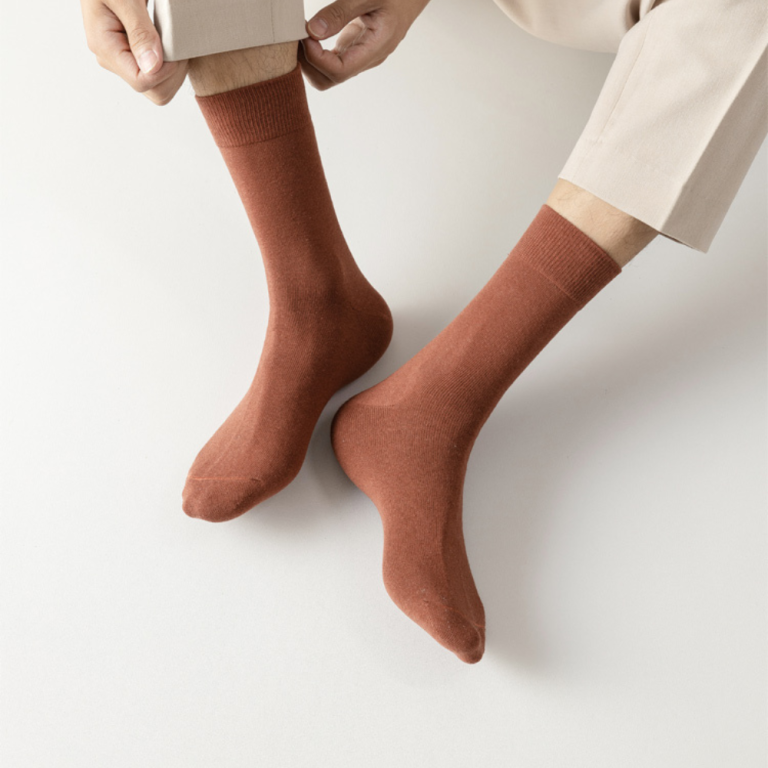Dress socks, often overlooked in the realm of men’s and women’s fashion, play a crucial role in enhancing comfort and style. Their material composition, though subtle, can significantly impact wearers’ experiences. From the comfort of natural fibers to the performance of synthetics and the elegance of luxury materials, the choices are abundant.

Perspective 1: Comfort and Breathability of Natural Fibers
Natural fibers, such as cotton and wool, have long been cherished for their breathability and comfort in dress socks. Cotton, known for its softness, is highly absorbent, making it ideal for keeping feet dry and comfortable. These qualities are particularly valuable during long days on your feet or in warm climates, where perspiration can be a concern. Breathability is one of cotton’s primary attributes, allowing air to circulate around the foot, preventing moisture buildup, and reducing the risk of blisters or discomfort.
Wool, on the other hand, is celebrated for its insulation properties. In the context of dress socks, this means warmth without overheating, making them suitable for colder weather or air-conditioned office environments. Wool’s natural moisture-wicking abilities ensure that your feet stay dry and comfortable, even when the weather turns chilly. The blend of both materials in some dress socks can provide a balance of comfort and insulation, making them versatile for various climates and seasons.
Perspective 2: Durability and Moisture-Wicking Properties of Synthetic Materials
While natural fibers excel in comfort, synthetic materials like nylon offer a different set of advantages. Nylon dress socks are celebrated for their durability and longevity. They resist wear and tear, making them a reliable choice for those who require long-lasting socks, especially in demanding work environments. This resilience ensures that dress socks maintain their shape and appearance over time, even with frequent use.
Moreover, the moisture-wicking properties of synthetic materials can be particularly valuable for active individuals. Whether you’re running from one meeting to another or engaged in physical activities, these socks efficiently manage perspiration, reducing the risk of discomfort and foot odor. The synthetic blends are engineered to keep feet dry, providing the breathability needed to maintain a fresh feeling throughout the day.
Perspective 3: Sustainability and Eco-Friendliness of Bamboo or Hemp Dress Socks
The world’s increasing focus on sustainability and eco-friendliness has given rise to alternative materials for dress socks. Bamboo and hemp are two such eco-conscious choices that have gained popularity. Bamboo, a highly sustainable resource, yields a soft and silky material that is comfortable against the skin. The bamboo plant is known for its rapid growth and minimal environmental impact, making it an excellent choice for eco-conscious consumers. The material is breathable, moisture-wicking, and biodegradable, aligning with the principles of sustainability.
Hemp, another eco-friendly option, is celebrated for its durability and resistance to wear and tear. Hemp dress socks are not only robust but also have a smaller ecological footprint compared to conventional materials. They can withstand frequent washing and maintain their integrity, providing long-lasting comfort while reducing the need for sock replacements. Furthermore, hemp fibers are moisture-wicking and naturally resistant to bacteria, contributing to a fresh and odor-free wearing experience.
Perspective 4: Luxury and Softness of Silk Dress Socks
When it comes to luxury, silk dress socks stand out as a choice synonymous with opulence. The unparalleled softness and smoothness of silk against the skin offer an indulgent experience. Silk is not only incredibly comfortable but also adds a touch of elegance to any outfit. The natural sheen and luster of silk are perfect for formal occasions or when you want to make a style statement.
Silk dress socks are not only about luxury but also about temperature regulation. They provide warmth in colder weather and remain cool in warmer seasons. The natural properties of silk make it an ideal choice for those who desire both comfort and sophistication in their dress socks.
In conclusion, the choice of material for dress socks is a highly personalized decision, influenced by one’s lifestyle, climate, and style preferences. Natural fibers like cotton and wool excel in comfort and breathability, while synthetic materials like nylon offer durability and moisture-wicking properties. Bamboo and hemp represent sustainable and eco-friendly options, while silk exudes luxury and softness. The diverse array of materials available ensures that everyone can find the perfect balance of style, comfort, and sustainability in their choice of dress socks. Whether you’re navigating a busy day at work or dressing up for a formal event, the right material can enhance your overall wearing experience.